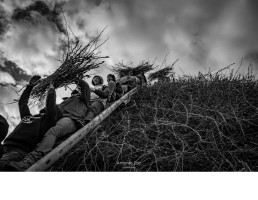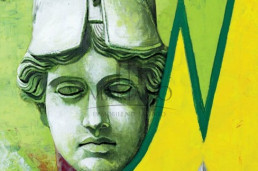The Marine Protected Areas of Salento and Their Relationship with Architecture and Construction: A Fragile Balance Between Conservation and Development
The Salento: Enchanting Coasts and the Challenge of Sustainability
The Salento, with its enchanting coasts washed by the Ionian and Adriatic Seas, has always been a territory that fascinates with its natural beauty and historical heritage. In this corner of Puglia, the Marine Protected Areas (MPAs) play a fundamental role in safeguarding marine and coastal ecosystems, while at the same time posing delicate challenges for architecture and construction, which must balance environmental protection with the growing demand for sustainable development. This article explores how the Salento’s MPAs interact with urban planning and architecture, focusing on possible solutions to preserve the integrity of the territory without compromising the region's economic and tourism dynamism.
What is a Marine Protected Area?
A Marine Protected Area (MPA) is a specific area of the sea and its coasts that is subject to special protection measures to safeguard natural habitats, marine biodiversity, and endangered species. MPAs are managed through specific regulations, which may include restrictions on human activities such as fishing, navigation, and construction, with the goal of reducing human impact on the marine and coastal environment. In Italy, the MPA system is an essential tool for protecting the natural marine heritage, and Salento is home to some of the most significant marine areas in the Mediterranean, attracting millions of visitors every year.
Marine Protected Areas of the Salento
The Salento, with its rich biodiversity and breathtaking landscapes, is dotted with MPAs that, besides being places of exceptional ecological value, play a central role in the region's tourism landscape.
 Marine Protected Area of Porto Selvaggio
Marine Protected Area of Porto Selvaggio
This MPA is one of the most significant examples of the beauty and ecological importance of the Salento. Located in the Nardò area, just a few steps from the natural park of Porto Selvaggio, this area protects a stretch of coast rich in Mediterranean scrub, sea caves, and crystal-clear waters. The area hosts a wide variety of marine species, including fish, mollusks, and occasionally dolphins.
The architecture developed around Porto Selvaggio is highly respectful of the environment. Modern buildings harmonize with the landscape, using natural materials such as Lecce stone and favoring architectural solutions that minimize visual and environmental impact. The buildings are designed to blend into the surrounding landscape, leveraging natural light and energy efficiency to reduce the use of non-renewable resources.
Marine Protected Area of Santa Maria di Leuca – Capo di Leuca
Santa Maria di Leuca, located at the southernmost tip of the Salento peninsula, represents another area of great interest among the region’s MPAs. Here, the sea meets history, traditions, and local culture. The protected area includes a wide range of marine habitats, from cliffs to Posidonia oceanica meadows, which are essential for biodiversity conservation.
Urban planning regulations in Santa Maria di Leuca are particularly stringent and greatly limit new constructions along the coast. This ensures that building development is responsibly directed, avoiding the construction of invasive structures that spoil the panoramic view. In this sense, the concept of "landscape architecture" is fundamental to urban planning, focusing on the restoration of old rural structures and promoting tourism that respects the environment.
 Marine Protected Area of Torre Guaceto
Marine Protected Area of Torre Guaceto
Located between Brindisi and Ostuni, Torre Guaceto is one of Puglia’s most important nature reserves. Characterized by salt marshes, sandy dunes, and crystal-clear waters, this area serves as a refuge for numerous species of migratory birds and marine fauna. The presence of extensive Posidonia meadows, among the largest in the Mediterranean, is crucial for coastal protection and marine biodiversity conservation.
In Torre Guaceto, land management focuses on enhancing local traditions and restoring rural architecture. The buildings, mostly restored from old farms and trulli, are integrated into the surrounding landscape, with particular attention to the use of eco-compatible materials and building techniques that minimize environmental impact. Restoring historic buildings helps maintain the connection with local tradition, while environmental respect promotes sustainability.
1. Rauccio Regional Natural Park
The Rauccio Natural Park, located in the Salento hinterland, is an area of particular ecological importance. Although it is not a marine area, the park protects numerous natural habitats, such as wetlands and Mediterranean scrubland. The park's management focuses on protecting native fauna and flora, but the surrounding areas are also subject to building restrictions to ensure that urban development does not compromise the integrity of the ecosystem.
2. WWF Le Cesine Oasis
Le Cesine is one of the most evocative natural oases in Salento, a wetland that is home to a rich variety of wildlife. The oasis is particularly important for the protection of migratory birds and endangered species. The area has been preserved from invasive building development, and the territorial planning of the surrounding areas includes the protection of the natural landscape and the promotion of eco-sustainable tourism.
3. Ugento Coastal Park
The Ugento Coastal Park is a nature reserve that extends along the Ionian coast of Salento and includes an important maritime and coastal area. Characterized by sand dunes, pine forests and cliffs, this park is essential for the conservation of natural habitats and for the protection of marine and terrestrial species. Here too, urban planning regulations aim to limit construction, encouraging redevelopment of existing structures and sustainable tourism development.
4. Punta Pizzo Park
Punta Pizzo is a protected area overlooking the Ionian Sea, known for its natural beauty and crystal clear waters. The area is ideal for the protection of dunes and Posidonia meadows, and is a popular destination for ecotourism activities such as birdwatching. The park was established to preserve the integrity of the marine and coastal environment, limiting the construction of new buildings and encouraging the adoption of architectural solutions that are in harmony with the surrounding natural environment.
 5. Palude del Capitano Park
5. Palude del Capitano Park
The Palude del Capitano is a wetland of ecological importance, which represents a precious habitat for many species of migratory birds and for the typical vegetation of the Salento marshes. In this area, urbanization is strictly controlled to protect the ecosystem and prevent irreversible damage to natural resources. The park, although not a marine area, is fundamental for the management of water resources and the conservation of the landscape.
Other Parks and Natural Areas of the Salento
Besides the aforementioned MPAs, Salento boasts other protected areas that are crucial for preserving local biodiversity and maintaining unspoiled coastal landscapes. These parks, although not necessarily marine protected areas, also contribute to environmental protection and impose building restrictions to prevent damage to the natural ecosystem.
Architecture and Construction in the Context of Marine Protected Areas
The MPAs of Salento place a strong emphasis on sustainability and responsible management of natural resources. However, the relationship between MPAs and architecture is not without tension, as building expansion and the growing demand for tourist facilities put pressure on environmental protection regulations. To balance the need for development with nature conservation, it is essential to adopt a sustainable building model that respects the specific characteristics of the coastal landscape.
Sustainable Tourism and New Architectural Solutions
Sustainable tourism is one of the main tools to ensure the protection of MPAs. Tourist facilities must harmoniously integrate with the environment, avoiding the construction of invasive buildings that could alter the landscape. In this regard, eco-compatible architecture plays a key role. Buildings near MPAs must meet low environmental impact criteria, such as using natural materials and renewable energy sources.
A significant example is the emergence of eco-resorts in Salento, designed to be energy self-sufficient and to minimize the use of natural resources. These structures not only offer a tourist experience respectful of the environment but also a development model that can be replicated in other marine protected areas.
Requalification and Recovery of Existing Buildings
Requalifying existing buildings, rather than constructing new ones, is one of the most effective solutions to reduce environmental impact. In many Salento MPAs, the restoration of historic buildings, such as trulli, masserie, and abandoned houses, has been encouraged as part of a heritage enhancement program. This approach not only preserves the historical memory of the area but also allows for new tourist facilities in already developed contexts, avoiding building speculation on untouched land.
Conclusions
The marine protected areas of Salento are a valuable heritage that deserves to be preserved for future generations. The relationship between environmental protection and building development is complex but can be managed with innovative and sustainable solutions that promote a balance between conservation and progress. MPAs, along with other parks and nature reserves in the region, offer a unique opportunity to develop tourism that respects the environment while promoting economic growth and enhancing natural resources.
Carnival in Salento: History, Masks and Traditions between Sacred and Profane
Carnival is one of the most heartfelt celebrations in Salento, a celebration rich in history, traditions and symbolic characters that tell the story of the deep bond between popular culture and territory. From allegorical parades to rites of passage linked to Lent, the Salento Carnival is a mix of joy, satire and tradition, with unique masks. But not only that: this celebration is also intertwined with the architecture and landscape of Salento, creating a fascinating combination of baroque theatricality and the soul of the local community.
The Origins of the Salento Carnival
The roots of the Carnival in Salento are rooted in ancient pagan celebrations linked to the cycles of nature and fertility. During the Roman era, the Saturnalia granted citizens days of celebration and subversion of social rules, a tradition that, with the advent of Christianity, was transformed into Carnival, a period of abundance before the Lenten penance.
Over time, Carnival has taken on unique nuances in the Salento area, developing iconic and ritual characters that still survive today in the popular festivals of numerous villages and cities.
The Typical Masks of the Salento Carnival
The Purgianella: The Mask of Castrignano del Capo
 The Purgianella is the mask, daughter of the classic character of Pulcinella, that represents the Carnival of Castrignano del Capo (LE), as well as the historical identity of the local inhabitants.
The Purgianella is the mask, daughter of the classic character of Pulcinella, that represents the Carnival of Castrignano del Capo (LE), as well as the historical identity of the local inhabitants.
He wears long trousers and a large white shirt tight at the waist to hold confetti underneath, once replaced by bran, a symbol of fertility and abundance. Of the same semiotic value are the lemons that the purgianelli jealously carry with them.
The true characteristic of the mask is its enchanting cone-shaped headdress, made with reeds and decorated with plumes and hundreds of colored paper ribbons, creating a colorful mane in the wind that recalls the wingspan of peacocks, a typical courtship gesture. At its end, the headdress has three lucky pumi, another reminder of love.
The outfit is completed by shawls on the shoulders, of different patterns but always very well-groomed, and a black mask on the face. Sometimes they have bandanas around their necks or handkerchiefs at their waists.
The Purgianella goes “hunting” for sweet girls, attracting them with citrus and showering them with confetti or, in the past, bran. More than courted, the girls were frightened, hence the local saying: «ci vide lu Purgianella cu sse chiusi e cu sse ’nserra» (“Whoever sees the Purgianella closes himself and barricades himself inside”).
Lu Paolinu: La Morte de lu Paulinu
In Martignano and in Grecìa Salentina, Carnival ends with “La Morte de lu Paulinu” (The Death of Paolino), a rite that represents the passage from revelry to Lenten penance. Lu Paulinu “Cazzasassi” (Pauline Stonecutter) is the puppet that personifies Carnival itself, celebrated with a theatrical funeral procession in which local actors stage a tragicomic comedy. The procession passes through the streets of the town accompanied by a shattered musical band and stops in front of the most prominent houses and shops, which offer food and wine.
Paulinu “Cazzasassi” (Pauline Stonecutter) is the puppet that personifies Carnival itself, celebrated with a theatrical funeral procession in which local actors stage a tragicomic comedy. The procession passes through the streets of the town accompanied by a shattered musical band and stops in front of the most prominent houses and shops, which offer food and wine.
At midday the traditional “consulu” takes place, a free public banquet in Piazza della Repubblica, based on tripe, potatoes and wine, in honor of the inconsolable widow Nina Sconza and all those who participate in Paulinu’s mourning. The evening ends with the burning of the puppet and the placing of the “Quaremma”, symbol of the beginning of the period of penitence.
Caremma: The Symbol of Lent
 Caremma is one of the most symbolic and fascinating characters of the Salento Carnival, embodying a deep bond with the religious and popular traditions of the region. This figure, an old woman dressed in black with a spindle in her hand, represents Lent, that period of fasting and penance that follows Carnival, marking the transition from the exuberance of the festivities to the sobriety of the 40 days of preparation for Easter.
Caremma is one of the most symbolic and fascinating characters of the Salento Carnival, embodying a deep bond with the religious and popular traditions of the region. This figure, an old woman dressed in black with a spindle in her hand, represents Lent, that period of fasting and penance that follows Carnival, marking the transition from the exuberance of the festivities to the sobriety of the 40 days of preparation for Easter.
Her appearance is deliberately austere and severe, to reflect the meaning of sacrifice and renunciation that Lent brings with it. Caremma is not only a figure of transition, but also a symbol of an ancient ritual, which marks the end of a cycle of abundance and freedom, to give space to a time of reflection and austerity. In the popular tradition of Salento, Caremma also served as a "living calendar" for the Lenten period. With a spindle in her hand, she tore out a feather or part of a symbol every week that passed, a gesture that marked time and reminded those who observed her of the path of purification and waiting that they were about to face. Each week of deprivation was “archived” in this way, giving Caremma an almost educational function, which taught patience and discipline.
The figure of Caremma, therefore, is more than a simple carnival mask: it embodies a balance between the profane and the sacred, between celebration and a moment of reflection, a symbol of the duality that runs through the Salento Carnival, where fun and joy give way to the serenity of fasting and penance, marking an essential passage towards Easter. Her presence in carnival celebrations becomes a reminder of how, even in moments of celebration, there is a cycle to be respected, a tradition to be honored, which carries with it a profound meaning and great symbolic value for the community.
The Traditions and Rites of the Salento Carnival
In addition to the masks, the Salento Carnival is characterized by rites and customs that reflect the cultural identity of the territory:
- The Allegorical Floats: Cities such as Gallipoli, Galatina and Corsano host parades of handcrafted floats, often with satirical figures inspired by current events.
- The Carnival Serenades: In some towns, the Carnival is accompanied by popular songs and traditional dances, in particular the pizzica.
- The Burning of the Fantoccio: In many places in Salento, the Carnival ends with the burning of a straw puppet, which symbolizes the farewell to the festival and the entrance into Lent.
The Link between the Carnival and the Architecture of Salento
 The architecture of Salento is closely connected to the carnival spirit, especially in the baroque cities such as Lecce and Nardò. The Baroque of Lecce, with its elaborate decorations, the scenographic excesses and the theatricality of its facades, reflects the exuberant spirit of Carnival, in which everything becomes a spectacle and a staging.
The architecture of Salento is closely connected to the carnival spirit, especially in the baroque cities such as Lecce and Nardò. The Baroque of Lecce, with its elaborate decorations, the scenographic excesses and the theatricality of its facades, reflects the exuberant spirit of Carnival, in which everything becomes a spectacle and a staging.
The historic squares, the heart of community life, are transformed into open-air stages during Carnival, where masks, actors and spectators mingle in a collective game of celebration and reflection.
The masserie of Salento, once the centers of rural life, have hosted more intimate celebrations and rituals linked to agricultural cycles for centuries, making Carnival a moment of transition between winter and spring.
Conclusion
Carnival in Salento is not just a celebration, but a collective ritual that tells the story, culture and transformations of the territory. Through figures such as Caremma, Paolinu and Purgianella, this tradition continues to live, intertwining satire, spirituality and fun. If you want to immerse yourself in the authentic atmosphere of Salento, Carnival is the perfect time to discover its masks, its customs and the charm of its timeless architecture.
Golden Fruits and White Stone: Citrus Fruits in the Aesthetics and History of Salento
A Divine Gift: The Greek Myth of Citrus Fruits
 According to Greek mythology, when Juno married Jupiter, she gave him as a dowry some trees that produced splendid golden fruits, oranges
According to Greek mythology, when Juno married Jupiter, she gave him as a dowry some trees that produced splendid golden fruits, oranges and lemons, eternal symbols of love and fertility. This symbolic meaning continues to this day, as demonstrated by the tradition of using orange blossoms in wedding bouquets.
and lemons, eternal symbols of love and fertility. This symbolic meaning continues to this day, as demonstrated by the tradition of using orange blossoms in wedding bouquets.
Jupiter considered those gifts so precious that he jealously guarded them in a magnificent garden, located in a remote region of the known world at the time, at the foot of Mount Atlas. To protect these legendary plants, he commissioned the Hesperides, young girls with melodious singing, assisted in their mission by the dragon Ladon.
Despite these precautions, Jupiter was unable to prevent their theft. During his eleventh labor, Hercules managed to take possession of the trees after a grueling fight that saw Ladon succumb. From that moment on, citrus fruits became accessible to humans, while maintaining their connection with divinity through the Greek term hesperidium, used in botany to indicate the citrus fruit.
 From Asia to the Mediterranean: the long journey of citrus fruits
From Asia to the Mediterranean: the long journey of citrus fruits
The cultivation of citrus fruits began in their region of origin, eastern Asia, around 2400 BC. Their journey to the Mediterranean was slow and progressive, passing through India and the Middle East. However, it seems that the Romans only knew the citron and the lemon, as evidenced by frescoes and mosaics of the time. It was only around the 7th century that the Arabs introduced the bitter orange, also known as melangolo, to Sicily.
Although many authoritative sources attribute the introduction of the sweet orange to the Arabs, there is no historical or literary evidence to support this thesis. Consequently, several scholars believe that the Portuguese were responsible for its spread, coinciding with the beginning of their colonial expansion in 1415. Evidence to support this hypothesis can be found in the diary of Vasco de Gama’s first oriental mission, in which he describes his encounter with sweet oranges: “sonvi melancie assai, ma tutte dolci…”. It is likely that the Portuguese discovered these fruits in the East and introduced them to Europe. Further confirmation is the fact that the sweet orange was called Portogallo, a name that persists in several southern dialects, such as those of Calabria and Salento (portagallu).
Citrus fruits in Salento: diffusion and importance
Citrus fruits, such as oranges, lemons and cedars, are not native to Salento. They were introduced into the Mediterranean area thanks to trade with the East, probably by the Phoenicians and later by the Arabs. During the Middle Ages and the Renaissance, these crops spread in Salento, thanks to the mild climate and fertile soil that favor their luxuriant growth.
Citrus gardens became an integral part of the local agricultural culture, and even today it is possible to find orange and lemon groves that adorn the Salento countryside, especially in the more humid and wind-sheltered areas.
The symbolism of citrus fruits: between religion and legends
Over the centuries, citrus fruits have acquired an important role not only from an economic point of view, but also from a symbolic one.
In ancient times, and especially in the Medieval period, the orange is a symbol of love: to give, receive, exchange. In the Christian context, together with the citron and the lemon, the orange symbolized the Holy Trinity: the three citrus fruits, distinct in shape, are unique in substance. Lemons and oranges were planted in the garden of the house as well as in the porticoes of churches, symbolizing the ancestors and the souls in mortal bodies. According to a widespread legend, which is linked to the passage of Saint Francis in Salento, also in Lecce, in the oratory next to the Franciscan church and convent, the seraphic father planted an orange tree. It also happened that one day Saint Francis, unable to feed his companions, asked for charity from a devotee who, deeply mortified at having nothing to offer him, closed the door. Unperturbed, Saint Francis knocked a second time, but received the same answer. He tried a third time and the man, uncomfortable at not being able to please the beggar, told him that he did not have even a crumb of bread in the house. In fact, that very year, even the only orange tree he had in the garden had not borne fruit. Saint Francis asked to be accompanied near that tree and the astonishment of the owner of the house was immense when he saw that the sterile plant had grown luxuriantly and had a large load of wonderful fruit.
 Citrus fruits and art in Baroque Salento
Citrus fruits and art in Baroque Salento
During the Baroque period, Salento experienced a period of great artistic and cultural ferment, and citrus fruits were considered symbols of purity, abundance and prosperity. They were often exchanged as precious gifts or used in events religious and ceremonies.
Citrus fruits were also used in the medical and cosmetic fields, thanks to their beneficial properties. Local traders exported these fruits to other territories, helping to consolidate the image of Salento as a land rich in natural resources.
Citrus culture is also visible in the art and architecture of Salento. During the Baroque period, local artists and architects began to use decorations inspired by citrus fruits in their works. Facades of churches and palaces, frescoes and sculptural details often include motifs that recall the golden fruits, a symbol of divine light and perfection.
A significant example is the Church of Santa Croce in Lecce, a masterpiece of Lecce Baroque. The intricate decorations of the facade include floral and natural motifs that recall the fertility of the Salento land, among which details that could be inspired by citrus fruits stand out.
Even in the historic gardens of noble villas, citrus fruits play an aesthetic and symbolic role. The “fenced citrus groves”, called “secret gardens”, were protected spaces where aristocrats grew citrus fruits not only for their nutritional value, but also for aesthetic and olfactory pleasure.
Citrus fruits and popular magic: macàre and spells
Even today in Salento you can hear about macàre and macarìe, and especially in the area of Grecìa salentina, from Soleto to Sternatia to Zollino. Stories, sagas, songs, nursery rhymes: there is a vast literature on the macàre (or “daughters of the night” as Petronius poetically called them), which speaks of witches and their raids. Their specialization is the macarìe, spells.
The simplest and most widespread is the one to find lost love, and the main protagonist is precisely an orange. It was necessary to obtain a lock of hair from the beloved and an orange (symbol of the world). Using the wax from a lit candle, a hole had to be made in the center of the fruit and the lock of hair inserted. At this point, the orange had to be wrapped in string and, after tying a tight knot, hung on a wooden stick. Finally, needles or pins had to be stuck into the peel, pronouncing the appropriate spells and ritual magic formulas at each puncture. After that, the orange had to be kept under the mattress: it would become a powerful talisman, capable of making the beloved return in a short time, tying him or her to the person who had performed the rite... just like the string tied around the orange.
 The game of "puni": when oranges became a pastime
The game of "puni": when oranges became a pastime
A hole in the center, five more around it. You would stand 4-5 meters away and throw a “rizza” orange (bitter, the bitter orange). If the orange stopped in one of the side holes, you won your stake; instead, whoever managed to get it into the central one took the entire prize pool.
This is the very ancient game of “puni”, whose name, in the linguistic islands of the old people of Terra d’Otranto, means “hole” or “pit”.
In Montesardo, in the Lecce area, puni was played until a few years ago, until the old players died. The games were played on spring and summer afternoons, on beautiful days, and the improvised playing field was located in the shade of the Chapel of the Immaculate Madonna. Players from all the nearby towns participated.
Today, in nearby Corsano, the “Idee a Sud-Est” Association has been organizing the Puni Championship for nine years, which this year was also opened to women. An ancient game, recovered and destined to be passed down to new generations.
Citrus fruits today: a legacy still alive
Today, the bond between Salento and citrus fruits continues to be strong. Many local farms have rediscovered ancient varieties of citrus fruits, growing them with organic and sustainable methods. Products such as jams, liqueurs (such as limoncello) and essential oils are exported all over the world, bringing a piece of Salento to international tables. In Salento, the mild climate makes this land ideal for growing citrus fruits. These trees are among the most common in urban gardens and rural areas, but it is especially in Alezio and the Gallipoli hinterland that their cultivation has reached a high level of specialization. Here, different varieties of sweet orange are grown with staggered ripening, in order to satisfy the provincial needs for a long period of the year. In addition to the most common varieties, such as the Arancio Biondo Comune, the Sanguinello and the Tarocco, there are lesser-known cultivars and numerous varieties of mandarins, lemons and rare citrus fruits.
Conclusion: a link between nature, history and culture
Salento and citrus fruits share a rich and fascinating history, which unites nature, tradition and art. This link is not only a testimony of the past, but also a source of inspiration for the present and the future. Strolling among the citrus groves of Salento or admiring the artistic details that celebrate these fruits is a way to discover the deep soul of this unique and generous land
Real Estate Market in Salento: All the Opportunities and Advantages of 2025
The real estate market is a constantly evolving sector, influenced by numerous economic and regulatory factors. Understanding the right time to buy, sell or rent a property is not always easy, but by analyzing trends we can make useful predictions for the future. So what are the prospects for 2025 in Salento? Let's find out together.
 A Recovering Market: What's Happening in Salento?
A Recovering Market: What's Happening in Salento?
After a period characterized by high mortgage rates and a limited real estate supply compared to demand, the market in Salento now seems to be stabilizing. The signs of recovery are evident, especially in the residential sector, where properties with a high energy class are attracting more and more buyers. The rental market is also recording an increase, with many families choosing this solution while waiting for better conditions for the purchase.
Salento, with its wonderful coasts and growing tourist attraction, is experiencing a strong increase in demand for properties for second homes and investments for hospitality purposes. The most sought-after locations include Lecce, Otranto, Gallipoli and Santa Maria di Leuca, where more and more Italian and foreign buyers are looking for investment opportunities.
Forecasts for 2025: Growth and Opportunities in Salento
According to estimates, the real estate turnover in Salento could increase by 6% in 2025. This positive trend is determined by several factors:
- Lowering interest rates: the European Central Bank is expected to further reduce rates, making mortgages more accessible.
New housing needs: families are looking for more energy-efficient homes with more space.
Incentives for sustainability: government policies are encouraging energy efficiency in buildings.
An interesting phenomenon concerns the growing demand for properties located outside large urban centers, in areas well connected to the cities but with more affordable prices and a better quality of life. In Salento, towns such as Maglie, Nardò and Tricase are becoming increasingly attractive for those who want a home with large spaces and close to the sea.
Buying a House in 2025 in Salento: Why is it Worthwhile?
One of the most important aspects for those who want to buy a house is the cost of the mortgage. Experts predict a drop in interest rates, with a possible reduction in the deposit rate between 1.75% and 2% by the end of the year. This could translate into lower mortgage payments. For example:
- A variable rate mortgage of 125,000 euros over 25 years could see the installment drop from 666 euros in 2024 to 649 euros in 2025.
Fixed rate mortgages offer increasingly advantageous conditions, with TAN starting from 2.48% and installments around 560 euros.
Those who already have a mortgage can consider subrogation, moving from a variable rate to a more convenient fixed rate (currently starting from 2.61%).
Furthermore, the Consap fund for first home mortgages has been renewed until 2027 with 670 million euros available. Those under 36 with an ISEE of less than 40,000 euros can obtain financing of up to 80-100% of the value of the property.
 Incentives and Tax Bonuses in Salento: Support from the PNRR
Incentives and Tax Bonuses in Salento: Support from the PNRR
The National Recovery and Resilience Plan (PNRR) offers various incentives for those who intend to purchase or renovate a property in 2025. Among the main ones:
- Superbonus (now reduced): still allows deductions for energy efficiency interventions and seismic risk reduction.
Ecobonus and Renovation Bonus: deductions from 50% to 65% for energy improvement interventions and building renovations.
Sismabonus: deductions of up to 85% for making buildings safe.
Green Bonus: 36% deduction for the arrangement of gardens and green areas.
Incentives for Digitalization: incentives for the installation of fiber optics and the digitalization of homes.
Renewable Energy Communities (CER): contributions for those who install shared photovoltaic systems.
In Salento, thanks to the favorable climate and strong tourist attraction, the energy efficiency of buildings represents a significant added value. Investing in sustainable solutions, such as photovoltaics or thermal insulation, not only allows access to incentives but also makes homes more competitive on the market.
Conclusions: A 2025 Full of Opportunities in Salento
2025 promises to be a favorable year for those who want to buy a house in Salento. With lower interest rates, government incentives and greater price stability, the real estate market offers excellent opportunities for buyers. If you are thinking of investing in a house in this wonderful region, this could be the right time to do so.
Smart Working, Workation and Slow Life: Salento as a New Home
In recent years, Salento has established itself not only as one of the most sought-after holiday destinations, but also as an ideal destination for those seeking a change of life. Post- pandemic housing trends, together with the growing popularity of remote working, have redefined the needs of those looking for a home, making Salento a perfect place to live. In this article, we explore how this region responds to the new demands of the real estate market, with a focus on spaces for smart working, a return to nature, and luxury housing solutions.
pandemic housing trends, together with the growing popularity of remote working, have redefined the needs of those looking for a home, making Salento a perfect place to live. In this article, we explore how this region responds to the new demands of the real estate market, with a focus on spaces for smart working, a return to nature, and luxury housing solutions.
Remote working: the ideal home in Salento
With the development of smart working, many professionals are choosing to move to places that combine high quality of life and excellent digital connections. Salento, with its natural beauty, a mild climate and a competitive cost of living, is confirmed as one of the most interesting choices.
 Ideal characteristics of homes for remote working in Salento:
Ideal characteristics of homes for remote working in Salento:
- Spaces dedicated to the home office: Villas in Nardò or Galatina offer large, bright studios overlooking centuries-old olive groves, creating an environment that stimulates productivity and concentration.
High-speed internet connections: Many places such as Lecce and Gallipoli are investing in digital infrastructure. Even villages such as Specchia and Presicce have equipped themselves with fiber optics, making online work possible even in more remote areas.
Relaxing settings: Villas in Porto Cesareo or Santa Caterina, equipped with panoramic terraces and gardens, allow you to balance working hours with moments of relaxation, perhaps with a breathtaking view of the sea.
The return to greenery: living in the villages and countryside of Salento
The pandemic has rekindled the desire to live in open spaces and immersed in nature, leading to a rebirth of the villages and countryside of Salento.
What buyers are looking for in this area:
- Private gardens and vegetable gardens: Renovated farmhouses near Otranto offer hectares of land where you can grow an organic vegetable garden, for a sustainable lifestyle.
Traditional architecture and modern comforts: In Santa Maria di Leuca, you can find renovated trulli and pajare, often equipped with infinity pools and photovoltaic systems.
Authentic communities: Living in villages like Borgagne or Specchia means rediscovering the value of authentic relationships and a slower lifestyle. These places offer affordable properties, often with large outdoor spaces and panoramic terraces.
 Urban luxury: condos with exclusive amenities in Lecce
Urban luxury: condos with exclusive amenities in Lecce
For those who prefer city life without sacrificing comfort, Lecce represents a new frontier of urban luxury. Known for its baroque architecture, the city is seeing an increase in high-end residential projects.
What the new luxury complexes in Lecce offer:
- Exclusive amenities: Residential complexes in the Mazzini neighborhood include spas, private gyms, condominium pools and roof gardens with city views.
Sustainability: Buildings constructed with eco-friendly materials and equipped with advanced energy-saving technologies, such as solar panels and water recovery systems.
Strategic locations: Penthouses in the historic center of Lecce combine modern design with breathtaking views of the baroque churches, offering the possibility of living near theaters, international schools and starred restaurants.
Workation and Southworking: new opportunities to live and work in Salento
The spread of remote working has made possible a new lifestyle called "workation", a combination of work and vacation. Salento is one of the most popular destinations for this experience, thanks to its ability to combine stimulating environments and relaxation.
An example is the startup Holiwork, founded in Lecce by Chiara Oliva and Georg Sauter. Holiwork offers a unique experience that combines luxury accommodation, nature, culture and gastronomy for those who want to work remotely in Salento. It is a new vision of the territory, no longer just as a tourist destination, but also as a place for professional growth and personal well-being.
Conclusions: Salento as a place of future living
Whether it is living in a masseria surrounded by greenery, working remotely with a sea view or choosing a luxury penthouse in Lecce, Salento offers housing solutions that meet the needs of the new living. This territory is the emblem of an authentic, sustainable and well-being-oriented lifestyle.
If you are looking for your ideal home, rely on real estate professionals to explore the opportunities that Salento has to offer. The future of modern living is here, between the beauty of nature and the innovation of new technologies. Don't miss the opportunity to turn your dream into reality.
BIT Milano 2025: Lecce and Salento on the rise, record tourism and a buoyant real estate market
Lecce, one million visitors in 2024: Puglia makes its way into foreign markets
 International tourism continues to drive Puglia's growth, making it one of the most sought-after destinations in Italy. At the Borsa Italiana del Turismo (BIT) 2025 in Milan, encouraging data were presented that confirm the positive trend: arrivals in the region in 2024 reached 6 million (+10.6% compared to 2023), while attendances almost reached 21 million (+9.7%). The data relating to foreign visitors is impressive, having increased by 22% compared to the previous year, reaching a share of 40.5% of total arrivals.
International tourism continues to drive Puglia's growth, making it one of the most sought-after destinations in Italy. At the Borsa Italiana del Turismo (BIT) 2025 in Milan, encouraging data were presented that confirm the positive trend: arrivals in the region in 2024 reached 6 million (+10.6% compared to 2023), while attendances almost reached 21 million (+9.7%). The data relating to foreign visitors is impressive, having increased by 22% compared to the previous year, reaching a share of 40.5% of total arrivals.
Puglia increasingly an international brand
A concept also reiterated by Rocco De Franchi, head of institutional communication for the Puglia Region, who
highlighted how the challenge was to transform the region into a globally recognizable brand.
«Today Puglia is no longer a collection of 250 bell towers, but a community that presents itself compactly to the world. Our strength is that of a people who work with determination to always improve», declared De Franchi.
A success that, as underlined by the Gazzetta del Mezzogiorno, is the result not only of public policies, but also of the ability of private operators to make the most of European funds and to build quality tourism offers.
Lecce on the rise: one million visitors
The capital of Salento has recorded record numbers with 375,484 arrivals and over 1 million visitors (+23% compared to 2023), surpassing Vieste and positioning itself in second place among the most visited destinations in Puglia, immediately after Bari. The significant increase in visitors testifies to the growing attractiveness of the city, which combines historical heritage, food and wine offerings and a renewed interest in experiential tourism.

Architecture and the real estate market: new investment opportunities
The tourism boom in Lecce has a direct impact on the real estate sector, with a growing demand for second homes from Italian and foreign investors. The Lecce Baroque, which embellishes palaces and churches, has become a major attraction for international buyers looking for exclusive residences. The real estate market sees an increase in interest in historic buildings to be renovated and transformed into luxury accommodation facilities, B&Bs and boutique hotels.
In recent years, the historic center of Lecce has attracted significant investment, with many buildings converted into charming homes. Demand is mainly supported by French, German, Swiss and English buyers, but also by Americans, fascinated by the authenticity and quality of life offered by Salento.
The strategic role of experiential tourism
Data analysis shows that tourists no longer limit themselves to visiting Lecce and its province in the summer months, but also choose the city in spring and autumn. Cultural events, food and wine tours and the possibility of exploring the region with a slow approach make the destination increasingly attractive. Roots tourism, which aims to rediscover one's Italian origins, is emerging as a growing market segment, especially among Italian-Americans.
Salento protagonist at BIT 2025
During the BIT in Milan, South Salento presented itself as a single tourist destination under the new brand "South Salento: a range of emotions", which enhances the diversity of the territory through three symbolic colors: the green of nature, the red of culture and the blue of the sea. This approach aims to strengthen the competitiveness of the region at an international level, focusing on an integrated tourist offer that includes historic villages, nature trails and slow tourism.
At the fair, tour operators specialized in incoming showed a strong interest in authentic experiences, from trekking on the ancient pilgrim routes to tastings of typical products. The demand for luxury stays is growing, with a preference for renovated farmhouses and historic residences.
Conclusions
Lecce and Salento are confirmed among the most sought-after destinations in Puglia, thanks to an effective tourism strategy and an expanding cultural and real estate offer. The growing presence of foreign tourists represents a decisive boost for the local economy and the real estate market, with increasingly interesting opportunities for those who want to invest in this land rich in history, beauty and authenticity. The future of tourism in Puglia appears bright, with Lecce ready to play a leading role.
Salento that marks time: the history and beauty of clocks
In the beautiful land of Salento, rich in history and traditions, clocks are not just tools to measure time, but authentic testimonies of the past. For centuries, towers and bell towers adorned with majestic dials have marked the rhythm of daily life, representing a deep connection between the land and its communities. Crafted by skilled watchmakers or integrated into extraordinary architectures, these clocks reflect a cultural heritage that combines functionality, beauty, and historical memory.
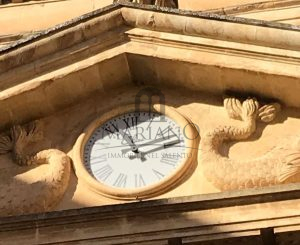 Through a journey to the most iconic places of Salento, we will discover how these timepieces tell stories of ingenuity, art, and identity, linking the past and present in a timeless narrative.
Through a journey to the most iconic places of Salento, we will discover how these timepieces tell stories of ingenuity, art, and identity, linking the past and present in a timeless narrative.
The clockmaking tradition of Salento stands out for its unique ability to combine the art of measuring time with a profound sense of territorial identity. In addition to the monumental clocks that decorate towers and churches, Salento has seen the rise of skilled watchmakers, including Giuseppe Candido, an emblematic figure in the art of watchmaking in Lecce.
Giuseppe Candido, active between the 19th and 20th centuries, was one of the most famous watchmaking craftsmen in the region. His craftsmanship and innovation left an indelible mark on the city of Lecce, where he created clocks that became true symbols of the city.
Candido was also distinguished for creating public and tower clocks, which not only served their function of telling the time but also enriched buildings with ornamental details and complex mechanisms. His works were the result of a perfect synthesis between mechanical functionality and aesthetics, reflecting the Baroque style of Lecce and the Salentine craftsmanship tradition.
In the splendid Piazza Sant'Oronzo in Lecce, stands a tower with a majestic clock, known as the "Clock of Wonders." Created in 1955 by the watchmaker Francesco Barbieri, this work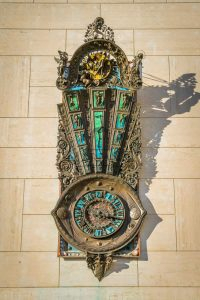 represents a blend of modernity and Baroque tradition, with details that evoke astrology, tarot, and Salentine symbolism. Despite the passage of time, the clock was recently restored and regained its former splendor, once again shining as one of the most significant symbols of the city.
represents a blend of modernity and Baroque tradition, with details that evoke astrology, tarot, and Salentine symbolism. Despite the passage of time, the clock was recently restored and regained its former splendor, once again shining as one of the most significant symbols of the city.
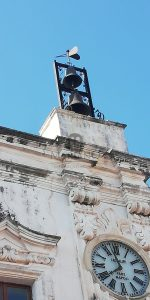 The civic tower of Nardò, with its precision clock, has regulated the life of the community for centuries. The clock is not just a timepiece, but a true testament to the ability of Salentine watchmakers to merge technique and art. It is one of the most significant examples of the history of watchmaking in Salento.
The civic tower of Nardò, with its precision clock, has regulated the life of the community for centuries. The clock is not just a timepiece, but a true testament to the ability of Salentine watchmakers to merge technique and art. It is one of the most significant examples of the history of watchmaking in Salento.
Located in the main square of Galatone, the tower houses a clock that has marked time for generations. This structure is a symbol of a deep connection between the city's historical past and its clockmaking tradition, continuing to serve as a point of reference for the locals.
The bell tower of the Cathedral of Sant'Agata in Gallipoli is an important landmark of the city, and inside, it houses both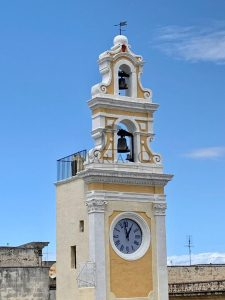 a clock and a sundial. The clock, located on the bell tower's facade, has marked the time accurately for centuries and is a fundamental part of the city's life. The sundial, also part of the tower, is an ancient instrument that measures time through the shadow cast by a gnomon on the surface below, serving as a reminder of traditional methods of observing the passage of time. Both instruments, the clock and the sundial, represent not only the functionality and ingenuity of past times but also a symbol of Gallipoli's history, where the measurement of time merges with the city's religious and cultural tradition.
a clock and a sundial. The clock, located on the bell tower's facade, has marked the time accurately for centuries and is a fundamental part of the city's life. The sundial, also part of the tower, is an ancient instrument that measures time through the shadow cast by a gnomon on the surface below, serving as a reminder of traditional methods of observing the passage of time. Both instruments, the clock and the sundial, represent not only the functionality and ingenuity of past times but also a symbol of Gallipoli's history, where the measurement of time merges with the city's religious and cultural tradition.
 The clock at the municipal headquarters in Maglie, located on the facade of the main building of the town hall, is a highly valuable historical and symbolic element for the city. This clock, which has marked the time for decades, represents an important point of reference for the local community. Its location, easily visible from the main square, makes it a symbol of city life and the Magliese tradition. The clock not only serves its practical function of measuring time but is also integrated into the historic architecture of the town hall, contributing to defining the identity of the place. Like many public clocks in Salentine cities, the one in Maglie is a testament to the city's evolution and the central role of the town hall in the daily life of the community.
The clock at the municipal headquarters in Maglie, located on the facade of the main building of the town hall, is a highly valuable historical and symbolic element for the city. This clock, which has marked the time for decades, represents an important point of reference for the local community. Its location, easily visible from the main square, makes it a symbol of city life and the Magliese tradition. The clock not only serves its practical function of measuring time but is also integrated into the historic architecture of the town hall, contributing to defining the identity of the place. Like many public clocks in Salentine cities, the one in Maglie is a testament to the city's evolution and the central role of the town hall in the daily life of the community.
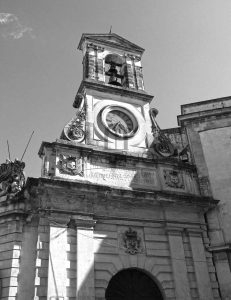 The clocks of the Civic Towers of Galatina and Noha are historical and cultural symbols of their respective communities. The clock of the Civic
The clocks of the Civic Towers of Galatina and Noha are historical and cultural symbols of their respective communities. The clock of the Civic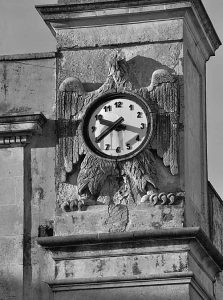 Tower of Galatina, built in the 14th century, has marked time for generations, becoming a visible landmark from the city. Similarly, the clock of the Civic Tower of Noha, located in the district of Galatina, is a central element in the life of the village, tied to local tradition and history. Both clocks continue to witness the passage of time and represent the connection to the past of the Salentine communities.
Tower of Galatina, built in the 14th century, has marked time for generations, becoming a visible landmark from the city. Similarly, the clock of the Civic Tower of Noha, located in the district of Galatina, is a central element in the life of the village, tied to local tradition and history. Both clocks continue to witness the passage of time and represent the connection to the past of the Salentine communities.
In Poggiardo, the bell tower of the church hosts a clock that has always been one of the distinguishing features of the town. Like the other clocks of the Salentine towers, this clock has marked the lives of the residents, setting the rhythm of the days and holidays. Its prominent position and precision mechanics make it a symbol of local tradition.
The clock of the Civic Tower of Casarano stands tall over the main square, uniting the history of the city with its community spirit. For centuries, the clock has marked the life of the people of Casarano, becoming an emblematic element of the city. The tower, with its clock, represents a connection between the past and the present, a symbol of continuity for the community.
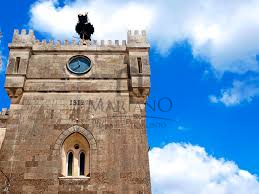 The clock of the Carpignano Tower, located on one of the medieval towers of the town, is another example of the Salentine clockmaking tradition. For generations, its sound has marked the beginning and end of the day, becoming a symbol of the bond between the people of Carpignano and their history. The Serrano Tower also hosts a clock that has been part of the daily life of the small community for generations. Like the other public clocks of Salento, this clock represents an integral part of the local tradition and continues to keep the memory of the past alive, marking the passage of time with punctuality and precision.
The clock of the Carpignano Tower, located on one of the medieval towers of the town, is another example of the Salentine clockmaking tradition. For generations, its sound has marked the beginning and end of the day, becoming a symbol of the bond between the people of Carpignano and their history. The Serrano Tower also hosts a clock that has been part of the daily life of the small community for generations. Like the other public clocks of Salento, this clock represents an integral part of the local tradition and continues to keep the memory of the past alive, marking the passage of time with punctuality and precision.
The monumental clocks of Salento are not just tools but authentic symbols that unite the past, present, and future. Their beauty, combined with technical precision and the skill of local artisans, makes these works a heritage that deserves to be preserved and enhanced. Each clock tells a story of art, culture, and ingenuity, linking the Salentine community to its history and traditions.
Whether it’s a tower overlooking a square or a clock adorning a historical building, each mechanism represents a chapter in the history of Salento, written with the skill of clockmakers like Giuseppe Candido, whose work continues to live through these extraordinary clocks that mark time with elegance and mastery.
What to do in Salento in December: Christmas and New Year’s eve between traditions and natural beauty
Located in the far south of Puglia, Salento is a region rich in history, culture, and natural beauty. While it is renowned for its breathtaking beaches in summer, in winter it transforms into an enchanting place where traditions, flavors, and spirituality blend to offer unique experiences. Visiting Salento in December, during the Christmas season and New Year’s celebrations, means immersing yourself in a magical atmosphere of lights, markets, folkloric events, and stunning landscapes. Here’s what you shouldn’t miss.
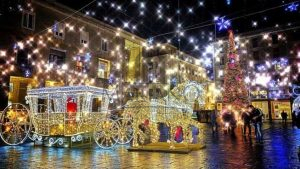 Christmas Lights and Markets
Christmas Lights and Markets
In December, Salento’s villages come alive with artistic illuminations adorning squares and narrow streets, creating a fairytale-like ambiance. Lecce, known as the “Florence of the South,” is especially enchanting with its Christmas decorations highlighting its baroque monuments made of Lecce stone, such as the Duomo and the Basilica of Santa Croce. Christmas markets are abundant, offering handcrafted goods, festive decorations, and local culinary specialties. Among the most notable are the markets in Maglie, Nardò, and Gallipoli.
The Tradition of Nativity Scenes
Salento is renowned for its long-standing tradition of nativity scenes. In particular, the living nativity scenes are a must-see event. Among the most enchanting is the one in Tricase, considered one of the largest in Italy, set in the natural park of Monte Orco. Here, hundreds of actors in period costumes recreate the Nativity in natural settings that evoke the Palestine of two thousand years ago. The nativity scene in Specchia is also worth visiting, with its artistic representations meticulously crafted in every detail.
considered one of the largest in Italy, set in the natural park of Monte Orco. Here, hundreds of actors in period costumes recreate the Nativity in natural settings that evoke the Palestine of two thousand years ago. The nativity scene in Specchia is also worth visiting, with its artistic representations meticulously crafted in every detail.
Another distinctive feature of Salento's tradition is the papier-mâché nativity scenes. Lecce is famous for this art form, which has ancient roots. Local artisans create detailed and lifelike figures using techniques passed down through generations. These nativity scenes can be admired in churches, museums, and dedicated exhibitions, such as those organized at the Carlo V Castle in Lecce. Visiting a papier-mâché nativity scene means discovering a unique art form that tells stories of faith and creativity.
Folkloric Events and Christmas Concerts
December is the perfect month to discover the popular traditions of Salento. Among the most anticipated events are sacred music concerts and Christmas carols, often organized in baroque churches. Additionally, the pizzica, the traditional dance of Salento, enlivens various festivities, bringing warmth and cheer even on cold winter evenings.
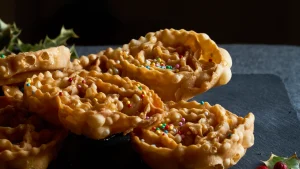 Food and Wine: The Flavors of Salento’s Christmas
Food and Wine: The Flavors of Salento’s Christmas
You can’t visit Salento without savoring its unique cuisine. During the holiday season, Salento’s tables are filled with traditional dishes such as pittule (savory fritters, which can be plain or stuffed with ingredients like salt cod, cauliflower, or sun-dried tomatoes), purceddhruzzi (fried sweets dipped in honey and decorated with colorful sprinkles), and cartellate (thin fried pastry sheets drizzled with vincotto or honey). In local restaurants and trattorias, you can also enjoy dishes featuring the freshest fish and other specialties from the region’s culinary tradition.
Walks and Nature Hikes
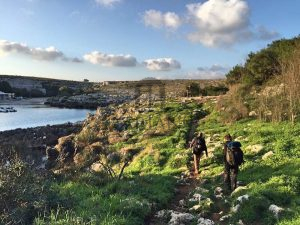 The mild climate of Salento in December allows you to fully enjoy its unspoiled nature. Ideal destinations for a walk include the Le Cesine Nature Reserve, the Costa Otranto-Santa Maria di Leuca Regional Nature Park, and the Tricase Forest. The coastlines, with their cliffs and deserted beaches, also offer breathtaking views. Don’t miss a visit to Punta Palascìa, the easternmost point of Italy, where you can watch the sunrise over the sea.
The mild climate of Salento in December allows you to fully enjoy its unspoiled nature. Ideal destinations for a walk include the Le Cesine Nature Reserve, the Costa Otranto-Santa Maria di Leuca Regional Nature Park, and the Tricase Forest. The coastlines, with their cliffs and deserted beaches, also offer breathtaking views. Don’t miss a visit to Punta Palascìa, the easternmost point of Italy, where you can watch the sunrise over the sea.
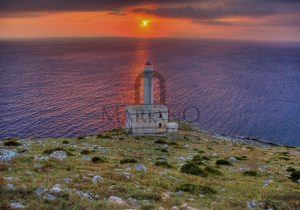 New Year's Eve in Salento
New Year's Eve in Salento
Celebrating New Year's Eve in Salento means choosing from a variety of events, from street parties to traditional festive dinners. Lecce, Gallipoli, and Otranto are the liveliest cities, offering live music shows, fireworks, and lots of fun.
A symbolic event is the "Alba dei Popoli" (Dawn of the People) in Otranto, a cultural celebration that marks the arrival of the new year with concerts, theatrical performances, and the eagerly awaited sunrise on January 1st, visible from the Adriatic coast.
Practical Tips for Visiting Salento in December
Clothing: Although the climate is mild, it’s advisable to bring warm clothes, especially for the evenings.
Accommodation: Take advantage of off-season offers to stay in masserie, B&Bs, or hotels at more affordable prices.
Transportation: It is recommended to rent a car to comfortably explore the villages and natural areas.
Conclusions
Salento in December is the perfect destination for those seeking an authentic Christmas, rich in traditions and set against a unique landscape. From living nativity scenes and genuine flavors to cultural events and breathtaking views, this land enchants in every season, making the Christmas holidays and New Year’s Eve unforgettable.
The Winter Magic of Salento: The Fòcara of Novoli and the Rite of the “Good Fire”
In the heart of January, the province of Lecce comes alive to celebrate an event of extraordinary cultural and religious significance: the Feast of Saint Anthony the Abbot, a deeply rooted tradition in the town of Novoli, in northern Salento. This event is a melting pot of history, legends, popular traditions, and devotion, culminating in a unique and spectacular blend.

Who was Saint Anthony the Abbot?
Saint Anthony the Abbot, who lived in the 3rd century AD, was a wealthy Egyptian heir born into a Christian family. He chose to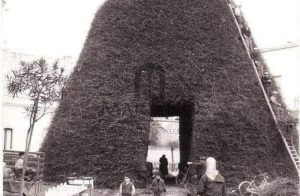 renounce all material possessions to live in the desert in poverty, dedicating himself to prayer and contemplation. Other men who sought to follow his example gathered around him, forming a community of hermits. The saint, who lived to the age of 105, is invoked as the protector of animals and those afflicted by the plague, partly due to the many legends surrounding him. One of the most famous tells of a sick piglet healed by the saint, which became his inseparable companion.
renounce all material possessions to live in the desert in poverty, dedicating himself to prayer and contemplation. Other men who sought to follow his example gathered around him, forming a community of hermits. The saint, who lived to the age of 105, is invoked as the protector of animals and those afflicted by the plague, partly due to the many legends surrounding him. One of the most famous tells of a sick piglet healed by the saint, which became his inseparable companion.
The figure of Saint Anthony the Abbot is closely associated with fire, a symbolic element of purification and renewal. According to legend, the saint descended into hell to confront Satan and steal fire to give it to mankind. This connection with fire is reflected in the tradition of bonfires, which are lit on the night of January 17th to burn away the past year's evils and welcome the new year with positive energy. The Fòcara of Novoli, the largest bonfire in the Mediterranean and Europe, is the emblem of this tradition.

The Fòcara: Between Rural Art and Modernity
For over three centuries in Novoli, the Fòcara has been skillfully built by the pignunai, expert craftsmen who use approximately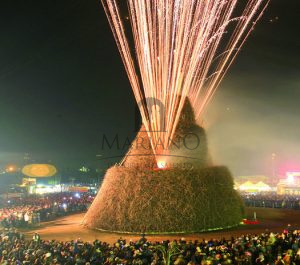 100,000 bundles of vine trimmings collected during vineyard pruning. This monumental structure, over 25 meters tall and about 20 meters in diameter, is the result of the efforts of one hundred volunteers working together for weeks. At the top of the structure, an effigy of the saint is placed, which burns during the lighting, accompanied by a captivating fireworks display.
100,000 bundles of vine trimmings collected during vineyard pruning. This monumental structure, over 25 meters tall and about 20 meters in diameter, is the result of the efforts of one hundred volunteers working together for weeks. At the top of the structure, an effigy of the saint is placed, which burns during the lighting, accompanied by a captivating fireworks display.
The Novoli festival takes place from January 16th to 18th and includes the traditional lighting of the Fòcara on the evening of January 16th. This moment is preceded by the intorciata procession, during which the statue of the saint is carried through the streets of the town by the faithful. The square fills with thousands of people who gather to witness the burning of the wooden structure, an event symbolizing hope and renewal. The atmosphere is enriched by Salento folk music and the spectacle of the fasciddre, sparks that create an enchanting “rain of fire.”

Over time, the shape of the monumental pyre has also evolved, becoming increasingly imposing and majestic. However, what takes place in the village just outside Lecce is an ancient, propitiatory rite that stretches back into the mists of time. In fact, scholars are still searching for its origins—its “zero date,” so to speak.
takes place in the village just outside Lecce is an ancient, propitiatory rite that stretches back into the mists of time. In fact, scholars are still searching for its origins—its “zero date,” so to speak.
According to some sources, the Fòcara was first lit in 1905, when “a heavy snowfall blanketed the bonfire on the eve of the celebration.” What is certain is the fame of the world’s largest “good fire,” which lights up and warms the night of January 16th. Its renown has surpassed the borders of this small village of just over nine thousand residents, becoming increasingly national and cosmopolitan.
The Feast of Saint Anthony the Abbot is much more than a religious event. Over the years, it has transformed into a true cultural and tourist attraction. With over 80,000 spectators annually, “The Days of Fire” serve as a gathering point for the agricultural community, an opportunity to promote local food and wine, and a means to highlight the Negroamaro Park.

The Fòcara of Novoli has been recognized as an element of intangible cultural heritage by the Region of Puglia and aspires to be included on UNESCO’s list of Intangible Cultural Heritage of Humanity. Over the years, internationally renowned artists have contributed to making this event even more extraordinary with artistic installations that have enriched the town’s cultural heritage. Among these are notable installations created
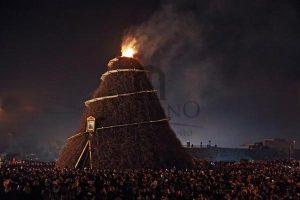
for the Fòcara, such as Mimmo Paladino’s papier-mâché horses, Ugo Nespolo’s colorful numbers, Hidetoshi Nagasawa’s concept of an external wooden spiral culminating at the top of the bonfire, symbolizing a peak reaching toward the universe and uniting Western and Eastern cultures, and Jannis Kounellis’s installation of a cross made with large stones and numerous iron lances placed on the Fòcara.
These and many other artists have donated signature posters of their works, further enriching Novoli’s cultural repositories, such as the “Pinacoteca di Arte Contemporanea” (Contemporary Art Gallery) and the “Museo del Fuoco” (Museum of Fire). Other notable figures, including Letizia Battaglia, Juliano Lucas, Edoardo Winspeare, Emir Nemanja Kusturica, and Tony Gentile, along with many others, have elevated this event to exceptional levels, both religiously and economically and culturally.
In January 2020, during the traditional Fòcara of Novoli, the Baronial Palace hosted a contemporary art exhibition. The display featured works by internationally acclaimed artists with the aim of creating a dialogue between modern art and local traditions. The exhibition enriched the Fòcara’s cultural program, emphasizing the importance of contemporary art within the context of popular celebrations.
Conclusions
The Feast of Saint Anthony the Abbot in Novoli is a unique event that seamlessly combines tradition and modernity. The Fòcara is not just a symbol of devotion but also a vessel of culture and identity for the entire community. Participating in this celebration means immersing oneself in a world of stories, legends, and traditions that reflect the most authentic soul of Salento.
Castrum Minervae: the archaeology of Salento conquering the present and abroad
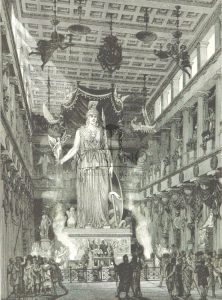 In the enchanting town of Castro lies one of the most extraordinary legacies of Greek and Roman civilization in Italy: the Sanctuary of Minerva, also known as the Athenaion. This legendary site, described by Virgil in the third book of the Aeneid, blends myth and history, culture and spirituality, creating a synergy that recounts centuries of devotion and encounters among Mediterranean peoples. Thanks to archaeological excavations conducted over the last two decades, Castro has regained its prominence as a crossroads of stories, legends, and art, attracting scholars, tourists, and enthusiasts from around the world.
In the enchanting town of Castro lies one of the most extraordinary legacies of Greek and Roman civilization in Italy: the Sanctuary of Minerva, also known as the Athenaion. This legendary site, described by Virgil in the third book of the Aeneid, blends myth and history, culture and spirituality, creating a synergy that recounts centuries of devotion and encounters among Mediterranean peoples. Thanks to archaeological excavations conducted over the last two decades, Castro has regained its prominence as a crossroads of stories, legends, and art, attracting scholars, tourists, and enthusiasts from around the world.
The Connection with Virgil and the Myth of Aeneas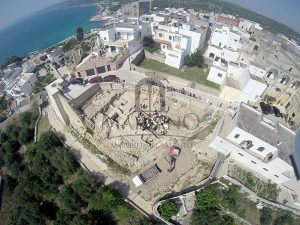
In the Aeneid, Virgil offers a poetic and symbolic depiction of the Sanctuary of Minerva: a temple situated on a promontory, glimpsed by Aeneas and his companions as they seek refuge after the fall of Troy. That promontory, identified by archaeologists as the site of Castro, was not only a guide for sailors but also a spiritual and cultural gateway to Italy. According to the myth, Minerva, the goddess of wisdom and strategy, was venerated here by the Trojans, who saw her as a symbol of hope and renewal.
The port of Castrum Minervae, overlooking the Strait of Otranto, was crucial for maritime routes connecting the Adriatic to the Eastern Mediterranean. This location was not just a landing point but also a crossroads of cultures: from the Greeks to the Messapians and finally the Romans, each civilization left its mark, transforming the sanctuary into a unique center of worship and commerce.
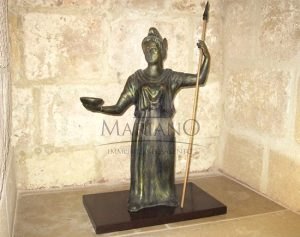 Excavations and Extraordinary Discoveries
Excavations and Extraordinary Discoveries
The rediscovery of the sanctuary was made possible by archaeological excavations initiated in 2007 under the direction of Professor Francesco D’Andria. These investigations uncovered a treasure trove of invaluable artifacts: fragments of ceramics, votive instruments, altars, and, most notably, monumental statues that confirmed Castro's importance in antiquity.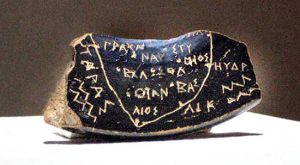
Among the most fascinating finds is a bronze statuette of Athena, unearthed in the early years of the excavations. This statuette, adorned with a Phrygian helmet, symbolically connects the sanctuary with the Trojan myth. The original Messapian settlement, influenced by the 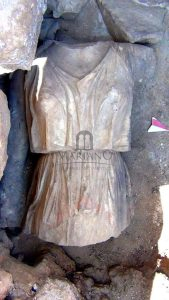 Spartan colony of Taranto, likely predated the Roman renaming of the area as Castrum Minervae. The ancient name of Castro, Lik, is corroborated by the so-called Soleto Map, a black-glazed shard featuring the oldest Western geographical map from classical antiquity, now housed in the National Archaeological Museum of Taranto.
Spartan colony of Taranto, likely predated the Roman renaming of the area as Castrum Minervae. The ancient name of Castro, Lik, is corroborated by the so-called Soleto Map, a black-glazed shard featuring the oldest Western geographical map from classical antiquity, now housed in the National Archaeological Museum of Taranto.
However, it was the discovery of a monumental bust of Athena in 2015 that established Castro as an internationally significant archaeological site. Originally standing over three meters tall, the statue was crafted from Lecce stone, a material typical of Salento known for its easy workability and durability.
In addition to these discoveries, fragments of other statues, including marble feet and decorated bases, were found alongside an altar dating to the 4th century BCE, evidencing animal sacrifices made in Minerva’s honor. These artifacts, along with ceremonial tools and ivory objects, tell of intense religious activity spanning centuries.
The Sanctuary of Minerva: A Beacon of Culture and Spirituality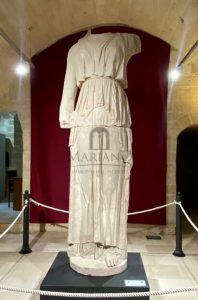
The Sanctuary of Minerva was not only a place of worship but also a symbol of cultural integration. Its strategic position, on a promontory overlooking the sea, made it a landmark for sailors and merchants and a destination for pilgrims from across the Mediterranean. Recognizing its sacred significance, the Romans incorporated the sanctuary into their network of temples, restoring and enriching it with architectural and artistic elements.
The statue of Athena, in particular, is an extraordinary example of Greek art and its influence in Salento. Scholars believe it to be the work of Tarantine sculptors renowned for their expertise in monumental art. The use of Lecce stone also confirms the presence of a highly skilled local network of artisans capable of creating works of great beauty and complexity.
The Museum and the Future of the Archaeological Park
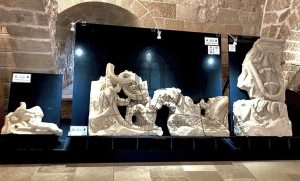 Today, the artifacts unearthed in Castro are preserved in the Archaeological Museum of Castro, housed in the Aragonese Castle. This museum offers visitors a captivating journey through the centuries, showcasing votive artifacts, statue fragments, and a reconstruction of the statue of Athena. In 2019, a replica of the statue was featured in the international exhibition “Gifts of the Gods. L’Apulia Felix between Greeks, Natives, and Romans” in Nanjing, China, earning acclaim and bringing global attention to Salento.
Today, the artifacts unearthed in Castro are preserved in the Archaeological Museum of Castro, housed in the Aragonese Castle. This museum offers visitors a captivating journey through the centuries, showcasing votive artifacts, statue fragments, and a reconstruction of the statue of Athena. In 2019, a replica of the statue was featured in the international exhibition “Gifts of the Gods. L’Apulia Felix between Greeks, Natives, and Romans” in Nanjing, China, earning acclaim and bringing global attention to Salento.
The site’s future is equally promising. With regional and national funding, the archaeological park in Castro will soon be accessible to the public. Visitors will be able to walk among the ruins of the sanctuary and immerse themselves in its history, guided by multimedia paths and virtual reconstructions that recount the sanctuary’s life during the Greek and Roman periods.
A Heritage to Discover and Preserve
The Sanctuary of Minerva in Castro serves as a window to the past, a place where myth and reality converge to narrate Salento's history as a crossroads of cultures, religions, and peoples. Thanks to the relentless work of archaeologists and institutional support, this site continues to yield discoveries and inspire new research. Visiting Castro today means embarking on a timeless journey, rediscovering the roots of a land that has always stood as a bridge between East and West.












